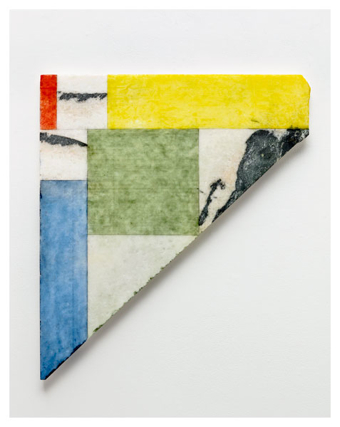
Brice Marden, "Formal Marble." 2011. Oil and graphite on marble, 72 x 64 cm. (Photo courtesy of Matthew Marks).
In another installment of We Went to Chelsea, we tell you why we’re not crazy about most of what’s up below 23rd Street. Next month, we’ll go higher. Our comments below on Gilbert and George, Tauba Auerbach, Brice Marden, Alice Neel, Philippe Decrauzat, Richteriana, and so much more.
Brice Marden: New Paintings at Matthew Marks
526 W 22 Street, 502 W 22 Street
Through June 23rd
Corinna Kirsch: Marden’s a king of monochrome and big loop-de-loops, so I was surprised to see that his recent work consists of small marble chunks covered with Mondrian-like designs. These works look like artifacts from an archaeological dig, and there’s one (Years) that’s shaped like a primitive dagger. What Marden has to say about the end of painting and abstraction here is clear: it’s in ruins, like a relic from the past. That view of abstract painting is depressing, and I don’t believe in it, but Marden also makes the end of painting bearable: some of his compositions look otherworldly, like lunar landscapes. Sure, the past might be dead and gone, but there’s something strange and unknown about it that astronauts (or arty-nauts) can explore.
Paddy Johnson: I dunno. The geometric shapes seem a little more reminiscent of Ellsworth Kelly if we’re going to go that way, and I’m not sure we should. The marble is an unaltered surface Marden responds to with paint, and the paint has a surprising amount of depth to it. This separates the work from that of both Kelly and Mondrian, whose abstraction isn’t at all responsive and is very much about flatness. It’s as if Marden is working with watercolor here.
I also would challenge the interpretation that just because the painting is on marble imported from Greece it’s necessarily a statement that painting is dead and gone. Marden’s abstractions are inspired by the landscape around him. I think this is just one more example of this, and a surprisingly good one at that.
Whitney Kimball: Are you guys kidding me? The impact relies entirely on artist-legend, the source of his materials, and the fact that he’s diluting his paints. All of this further emaciates what’s high on my list of most boring shows of all time. If this were in a Bushwick gallery, I don’t think we’d look twice.
I’m also sick of unjustified fetishizing of found objects. Artists like Ian Pedigo verifiably turn detritus into gold, but that’s because he’s doing much more than just placing it on a pedestal or putting his stamp on it. Marden’s speaking to materiality, history, and the fact that these are from a landscape. That description applies to almost anything.
Paddy: Wow. I totally disagree. I really think there’s something to the surfaces of these things, and that materiality is central to that.
Anthony Espino: Take a second to visualize Brice Marden dressed in all white, walking along the shore of the Grecian island Hydra, hand-selecting chunks of marble. Of course, afterwards, he would take a seat on a wet rock to carefully paint each one while speaking softly to the slab under a setting sun.
Corinna: What a babe.
Philippe Decrauzat at Elizabeth Dee
545 West 20th Street
Through June 23rd
Corinna: Decrauzat’s show is a structuralist yawn about art that can cause a breakdown in the smooth flow of looking: that forward slash is half of an “x”; those wavy lines break up the flatness of the canvas; and that flickering landscape in the film chops up the screen. Overall, I’m bored by Decrauzat’s severity. I think he could use some playfulness.
Whitney: The film (Screen-O-Scope) wasn’t on when I went, so that probably changed things. Decrauzat claims that the paintings form a loop. In between the optical waves, there’s a /, then an X, then an upside-down V, then a diamond, which could read as frames of a strand of X’s on a strip of film….? It looks like a puzzle, but it could just as easily be a bunch of intentionally-misleading hints. A pane of glass in the other room displays a labyrinth of swastikas.
Op art and moire patterns seem to be a worldwide trend, so it’s worth considering why we’re not addressing it more.
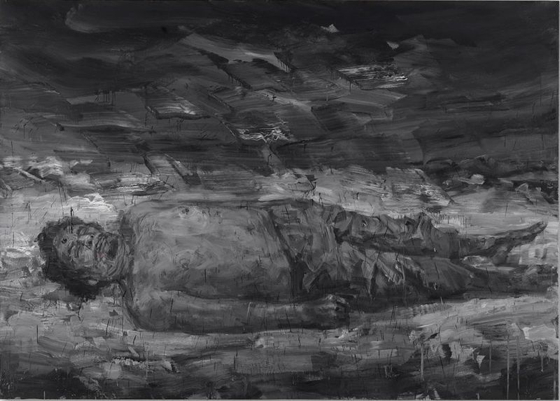
Yan Pei-Ming, "Gadhafi's Corpse - October 20th 2011," 2011. Oil on canvas, 110 1/4 x 157 1/2 inches. (Photo courtesy of David Zwirner).
Yan Pei-Ming: Black Paintings at David Zwirner
519 West 19th Street
Through June 23rd
Corinna: Yan Pei-Ming isn’t a great painter. The only thing interesting about these paintings is trying to figure out what historical subject he’s riffing on: Oh, is that a Goya? Is that a Parthenon I see peeking out from those black swaths of paint? Yep. It’s a game to keep busy from being bored by his swathy gestures.
Whitney: Same. With the gimmicky brushstrokes and the portraits of Gadhafi’s corpse and Pablo Picasso, this whole show feels very calculating.
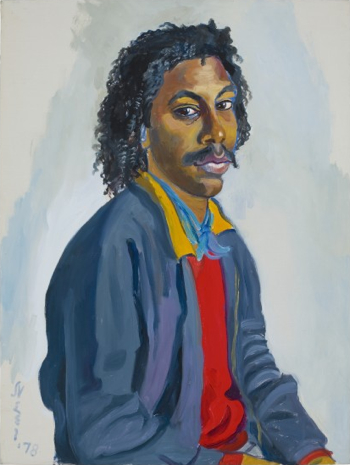
Alice Neel, "Stephan Shepard," 1987, Oil on canvas. Framed: 34 3/4 x 26 3/4 x 1 3/8 inches. (Photo courtesy of artobserved.com).
Alice Neel: Late Portraits & Still Lifes at David Zwirner
525 West 19th Street
Through June 23rd
Corinna: Alice Neel fails when her portraits focus on the clothing and style of her sitters, which range from a Jheri curl hairdo to Keith Richards-style leather pants. What Neel succeeds at, however, is making devoutly unglamorous portraits while playing around with paint. These paintings are fun, and the worked surface shows a deep consideration of the painted canvas. She has a regard for her sitters that shows through.
Whitney: I agree, I think regard for sitters says a lot about Alice Neel. These are very friendly. That doesn’t make for much variation, but it sure is likeable.
Unrelated, but no, that’s not Lionel Richie.

Greg Allen, "Destroyed Richter Painting No. 3," 2012. Oil on canvas 48 x 48 inches. (Photo courtesy of Postmasters Gallery).
Richteriana at Postmasters
459 West 19th Street
Through June 16th
Whitney: Now is a crucial time to talk about Richter. He’s the top-selling living artist, but unlike 20th century masters, he’s a bit of a cultural island. Is this postmodernism, or is his prolific output and appealing aesthetic just perfectly tailored to the market?
On their site, Postmasters linked to Felix Salmon’s case for the latter. The article includes Citibank’s art advisory chart, measuring Richter’s monetary value against Warhol, de Kooning, Picasso, and the S&P 500.
The group show includes work by seven artists, all with very different approaches. Greg Allen is showing paintings of photos of destroyed pre-fame Richter paintings from the 60s, which were rejected by the market. Allen writes on his blog that the work isn’t meant to be viewed online because the experience is meant to duplicate that of encountering the paintings in person at that time. These were made from photos at a Chinese paint farm, which brings us squarely back to today’s market. It’s a great idea, though you can’t help but focus on the hasty brushstrokes of the individual paintings. It’s possible that these are very close copies, but even at his blurriest, Richter tends to be crisper.
David Diao and Rory Donaldson are both showing work that’s similar to Richter’s squeegees. Diao’s 1972 acrylic painting Wealth of Nations predates Richter’s, while Donaldson’s are digital photos from 2012. Diao also blew up a 1985 catalogue essay and replaced Richter’s paintings and name with his; this doesn’t prove anything about Diao’s rightful place in history, but instead shows that the hero-worship is overblown.
Raphael Rozendaal’s colorflip.com allows you to flip colored page after page, in a theoretically infinite stack of sheets. Like the Chinese paint farm, and Diao’s and Donaldson’s works, this pointed to the fact that there are infinite variations on squeegee painting.
Corinna: Yep. It’s a good time to look at Richter. Adding to that list of things Whitney mentioned, let’s not forget that Richter documentary that came out earlier this year. The issue I’ve got here is just what a show about Richter’s influence, without including Richter in it, really means. Does it mean that Richter’s style and content has been adopted by other artists, or that Richter isn’t the only one who can make large, colorful, photo-realistic abstractions?
I’m hard-pressed to locate Richter’s style, but I know it when I see it. And I don’t see anything completely similar to a Richter in this show. Maybe that’s a good thing, but most of the show focuses on colorful abstraction, Greg Allen’s work being one of the few exceptions.
Some of the work in the show, like Fabian Marcaccio’s Militia Family, (2012) is just a whole lot of goopy paint. Richter was never into globbing paint onto a canvas and quite frankly, none of the works in this show live up to being exceptional abstractions.
Jutta Koether: The Fifth Season at Bortolami
520 West 20th Street
Through June 16th
Whitney: The gallery floor is filled with a terracotta gravel, which gives this a Mediterranean setting. The series is Koether’s take on Poussin’s “The Four Seasons.” Geometric and floral motifs mash up Biblical and Medieval subjects, while the airy marks make them feel like faded Greco-Roman murals. Diagonals, lightning bolts, and dotted vines zig-zag throughout. One smaller painting of a cat’s back provides a solemn pause.
Koether’s paintings share a flaming campy-funk with artists like Allison Schulnik, Angela Dufresne, and Dana Schutz. In addition to “Spring,” “Summer,” “Fall,” and “Winter,” paintings have titles like “Bacon” and “Balls”; in “Spring,” a touristy couple grins at us through leafy zig-zags, and the guy peers through breasty binoculars. Like music or performance, these are less about product than energy. A lot of artists have tried to bring a musical function to painting, and Koether does it well.
Koether showed four more paintings at the Whitney Biennial and had a related performance at the gallery.
Corinna: So many kitties! Whitney, I really dig your comment about Koether’s music. I didn’t notice it at first, but there’s a rhythm found in the airiness of these works, their heavy lines and floating figures.
My beef with these paintings is that the mythology Koether presents—the cats, the Greek stuff, the symbols—is too vague. Even with the musical aspect to her work, I still can’t glide into her imaginative landscapes.
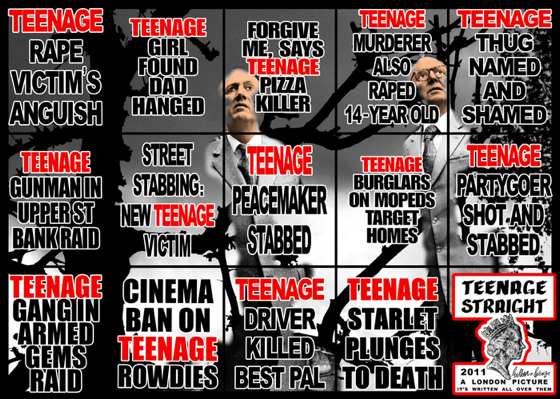
Gilbert and George, "Teenage Straight," 2011. 89 X 124 3/4 inches. (Screenshot courtesy of Sonnabend Gallery).
Gilbert & George: London Pictures at Sonnabend
536 West 22nd Street
Through June 23rd
Corinna: Gilbert and George’s London Pictures have taken over both Lehmann Maupin locations. I’m not sure why there’s so many of them, other than that there’s some power in repetition. All these works use text from some sort of news story, usually something from the tabloids, and put the word they have in common in red. They’re better than I thought they would be, but I just wish Gilbert and George would stop putting themselves in their works. It’s a completely moot point for them to continue sticking their faces onto a work like the one above.
Whitney: I think it makes sense to have so many because these are from posters of news headlines, and massive exhibitions is their thing. The several-paragraph press release is displayed on the outside of the gallery’s storefront windows, which was actually a good thing.
The word in the bottom right corner indicates the common word, which seems purely based on frequency; ”bombing,” “mother” and “soccer” are just a few. They’ve added the word “straight” after some of the common words, meaning only that the font on that grid will not look handwritten. This banal distinction points to the fact that groups outside the mainstream (I guess middle-aged straight whites) will be noted as such (like “gay marriage” versus “marriage”, “black man” versus “man”, etc). Because there are so many headlines, the differences between social groups, even victims versus criminals, start to seem irrelevant. “Woman, aged” and “addicts” feel particularly insidious. In the background, it looks as though they mindlessly played around with the Photoshop masks and clone stamp, which also fits well.
Dana Schutz: Piano in the Rain at Friedrich Petzel
537 West 22nd Street
Through June 16th
Whitney: Dana Schutz is a fucking outstanding painter. Not one chunk of color looks labored or out of place. I wouldn’t be surprised if she whipped these out in a month.
The energy is so thrilling that you don’t need much else, but the subjects seem more detached. Swimming, Smoking, Crying and Face Eater are farcical, but there’s an absolute, drowning wretchedness there; that pathos seems mimed here in paintings of a girl shooting heroin in the wind, and an open trench coat spewing gestural wares. There were more open-ended gestures which give room to think, though, like Hop, (a pink figure raising its arms to a balding man in a sweater) and Small Apartment (a couple hunched over tissues at a dinner room table). The massive Building the Boat While Sailing could be her Guernica.
Corinna: Yep. These are amazing. Little details and texture swim all over her canvases and they really are just thrilling to look at. In terms of music, these are *way* more rhythmic than Jutta Koether’s work.

Tauba Auerbach, "Untitled (Fold) I," 2012. Acrylic paint on canvas on wooden stretcher; 64 x 48 in. (Photo courtesy of Mousse Magazine).
Tauba Auerbach: Float at Paula Cooper Gallery
521 West 21st Street
Through June 9th
Whitney: Sexy design.
Corinna: Auerbach’s hit on a good formula of making objects in the world around us seem Photoshopped, and then transforming those things back into the safe confines of a canvas. I don’t have a problem with her work, and it’s totally sexy, but by now, it just looks too formulaic.
Whitney: Yeah, artist photos in an open binder on the desk added to the showroom quality. They’re gorgeous, but that’s all they seem to be telling us.
Ernesto Neto: Slow iis goood at Tanya Bonakdar Gallery
521 West 21st Street
Through May 25th
Corinna: Not another show that lets people crawl and nap on things. This time, you can climb on an artist’s jungle gym *and* look at some potted plants. Eh, maybe I just hate fun.
Whitney: Insert some rambly statement here about weightlessness juxtaposed with modern life, and it’s an art hammock! (Art hammocks are self-aware, regular hammocks are idiots). It was fun, they were beautifully crafted, and I would love to have one. I think most people would, because people like hammocks.

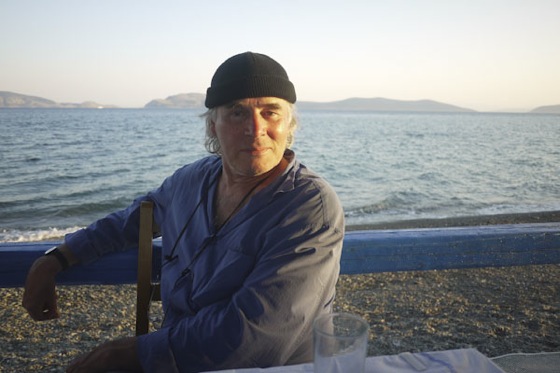

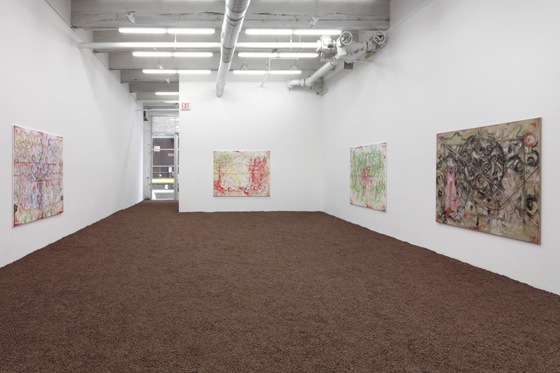

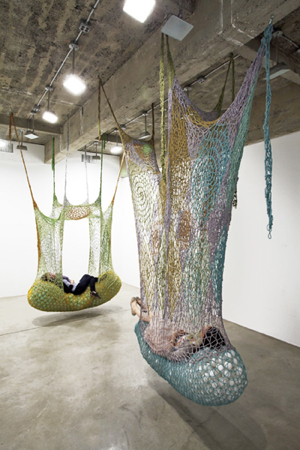

{ 4 comments }
I googled “chinese paint farm” and only two matches came up which were both links to this article. So I still don’t know what a Chinese paint farm is but I love the term.
I haven’t asked him specifically, but I’m almost positive Greg got the painting done in Dafen, or the area immediately around it—there’s an officially-sanctioned community of thousands of artists, most of whom are employed painting from JPEGs. I don’t know that anyone’s written a definitive article about it, but I wrote an (unpublished) essay about it once, so here’s the best paragraph and a few links:
“The story of Dafen Oil Painting Village is one which has garnered a fair amount of media attention in the past five years. The facts recounted are generally thus: in 1989, a man named Huang Jiang moved from Hong Kong to Dafen, a suburb of Shenzen in Southeastern China, bringing with him the skills and idea of copy-painting. Establishing a small workshop, he began producing hand-painted replicas of canonical Western paintings, from da Vinci to van Gogh to Richter, for export, eventually earning contracts with major Western retail firms. Over the next twenty years, other entrepreneurs joined in, spurred by the region-wide economic boom, expanding the model to portraiture (often through e-mailed family photographs) and bespoke painting. 60% of the world’s oil paintings are now produced within Dafen’s limits, in an industry worth something on the order of forty to fifty million dollars annually. The production is generally still workshop-based, with painters working semi-autonomously to fill orders individually; occasionally, a more divided system of labour exists akin to that of Renaissance painting, wherein less skilled painters produce backgrounds and landscapes while more skilled artists paint foregrounds and faces. The eventual buyers are generally hotels, restaurants, and middle-class Westerners, looking to decorate their homes with fine art without breaking the bank (a replica of one of van Gogh’s Sunflowers retails for somewhere between £20 and £40, depending on quality and, interestingly, size).”
http://www.asiasentinel.com/index.php?option=com_content&task=view&id=229&Itemid=34
http://www.regional-office.com/?p=16
I haven’t read this one, but Evan Osnos is an excellent, excellent writer: http://articles.latimes.com/2007/feb/18/news/adfg-chpix18
http://www.theatlantic.com/technology/archive/2007/12/workshop-of-the-world-fine-arts-division/7859/ And Michael Wolf took some excellent photographs; I particularly love the one with the giant Mona Lisa: http://www.photomichaelwolf.com/china_copy_artist/
Nice stuff about Dafen, but it turns out that’s not where I got the paintings. I only found out when they shipped that the artists I worked with are in Xiamen, specifically the Wushipu Oil Painting Village. It’s the second largest concentration of industrial-scale painters.
I also found out that Clement Valla did his RISD thesis project with Wushipu artists, poking around the conceptual structures of the paint-to-order system.
And though Chinese Paint Farm is a great coinage, I’ve been using Chinese Paint Mill myself, a term that first came up in a Twitter conversation with @Powhida.
Wushipu is clearly the more underground option 🙂
Comments on this entry are closed.